Dogs chew. Like, a lot! In fact, chewing is a natural dog behavior that can relieve stress, prevent boredom, and even help clean a dog’s teeth. But not all chews are created equal, and some are even downright dangerous for dogs. From toxic chemicals, to choking or blockage risks, and even chipped teeth, chews can sometimes pose as much of a health risk as they do a benefit. So, I put together a list of my favorite safe dog chews along with tips for choosing the right chew for your specific dog.
Some dogs chew more than others, and some dogs chew harder (or more aggressively) than others. It is crucial to choose the best dog chew based on your dog’s age, chewing habits, health, and even personal preference.
The goal of choosing safe dog chews is to meet your dog’s needs without posing unnecessary risk. That said, all chews pose some level of risk to your dog. I always recommend checking with your veterinarian about all matters related to health and wellness, including what chew would work best for your dog.
*Disclosure: This post contains affiliate links. This means that I may earn a small commission, at no additional cost to you, if you make a purchase. Thank you for supporting my blog! I only recommend products I use myself, and all opinions expressed here are my own. Read my full disclosure here.
What Makes a Safe Dog Chew?
Several factors go into making a dog chew safe. I like to consider ingredients, sourcing, and preparation, as well as size and density. In my opinion, the best dog chews are natural with minimal ingredients, and they are easy for your dog to chew on but difficult for your dog to fit into their mouth and swallow.
Many products, like rawhides and bully sticks, are treated with chemicals and preservatives that can be toxic to our pets and make them sick! Other chews, like nylabones or benebones are just plastic. Not only is plastic completely indigestible, but it also harbors bacteria and can slice up your dog’s gums, leading to infections and other problems (not to mention the sustainability issue).
Yet, just because a chew is “all natural” does not automatically mean it is safe. Antlers are a great example. We LOVE antlers, and they work well for our dogs. But, really aggressive chewers could easily break a tooth on an antler. Not only is this painful for your dog, but it can also be an expensive vet bill since broken teeth require surgery to extract.
So what makes a dog chew “safe”?
Here are my guidelines:
- 100% digestible
- Nontoxic ingredients (no chemicals, artificial colors/flavors, or other additives)
- Hardness of chew aligns with chewing intensity of your dog
- Size of chew aligns with your dog’s size (when in doubt, size up)
Lastly, you should always supervise your dog while they chew, and don’t let your dog chew for than 10-15 minutes at a time.
The Ultimate List of Safe Dog Chews
Below is the ultimate list of safe dog chews. They are listed in order of softest/safest to hardest/longest lasting. Plus, I’ve included a description of each item so that you can find the chew that works for your specific dog.
Remember, some dogs are more aggressive chewers than others, or have stronger jaws; some dogs, like seniors, have softer teeth. Likewise, different sized dogs will need different sized chews, as smaller chews pose a choking risk to larger dogs. Be sure to consult your veterinarian if you have any questions or concerns.
Rolled Fish Skins

Icelandic+ has some great fish chews that are perfect for all dogs! They are especially great for light chewers or dogs with softer teeth. They are high quality, single ingredient chews full of Omega-3 fatty acids, which support a healthy skin and coat for your pet. These treats are definitely smelly, which might be gross for humans, but it drives the dogs wild!
These crunchy chews are easily edible and highly digestible. They don’t pose a choking risk, and it’s unlikely your dog will chip a tooth or suffer a blockage with one of these super safe dog chews. That said, many dogs gobble these chews up quickly, as they are not intended to be super long lasting.
Beef Tendon
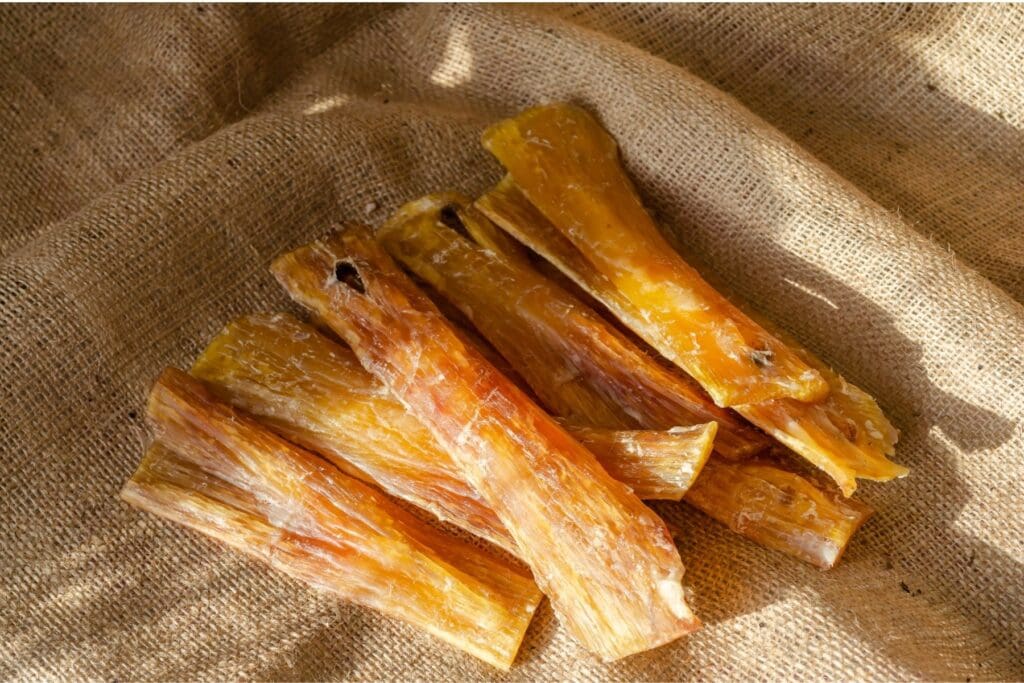

Dried beef tendons are a safe dog chew for all dogs, as long as you choose the appropriate size. They are edible enough to not pose a tooth chipping problem. At the same time, they are strong enough to give your pup something to gnaw on. They won’t last too long with an aggressive chewer, but that is not necessarily a negative.
Tendons are great for cleaning teeth and giving your dog or puppy a healthy outlet for the natural behavior of chewing. Like with many chews, it’s important to select a quality company. Select a product that does not have harsh chemicals, preservatives, artificial flavors/colors, or other additives in their products.
Beef Trachea
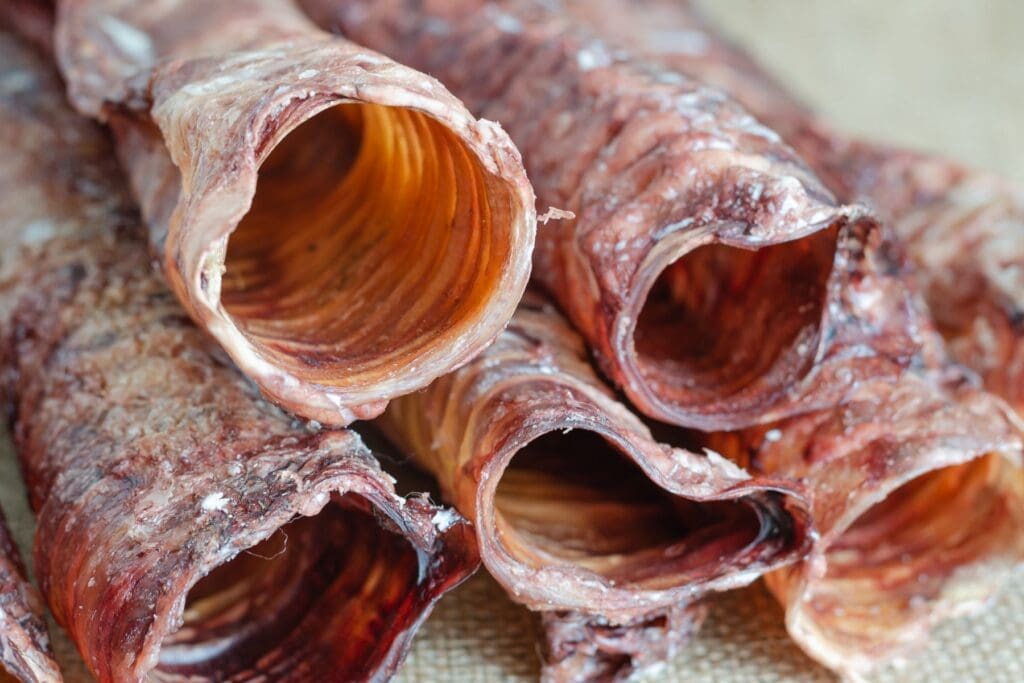

Beef trachea are a great chew option for any dog! If you have a small dog, you can get the 2-3″ tracheas or even trachea rings (like these). Alternatively, if you have an extra large dog, you can get the monster trachaes that are quite huge (sometimes 12-18 inches)! Tracheas are great for stuffing with wet dog food, pumpkin, peanut butter, etc. Plus, they are soft enough that you don’t need to worry about your dog chipping a tooth.
Be sure to choose a trachea free from chemicals, artificial colors/flavors, preservatives, and other additives. Personally, I avoid the ones that come pre-stuffed, too, as oftentimes the ingredients aren’t the best.
Beef Gullet
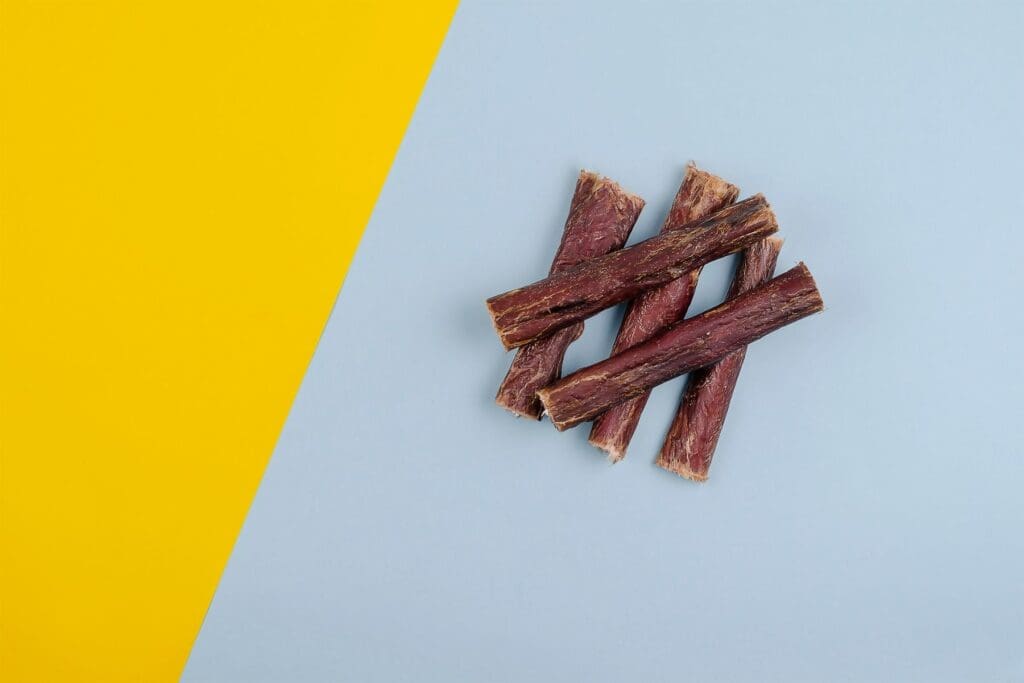

Similar to the ever popular bully sticks (which I’ll talk about next), gullet sticks are made from the esophagus of a cow. They are a little softer and easier to eat than bully sticks, making them perfect for light chewers or dogs with softer teeth, like seniors. They are also great for smaller dogs and even cats!
One of the top complaints about beef gullet chews is that they don’t last very long. However, it’s important to move away from the idea that a chew should keep your dog occupied for hours. Instead, safe dog chews should be easy for your dog to gnaw on so as not to pose a health risk. You still get all the benefits of a good chew without the dangers of broken teeth or splintering.
Bully Sticks
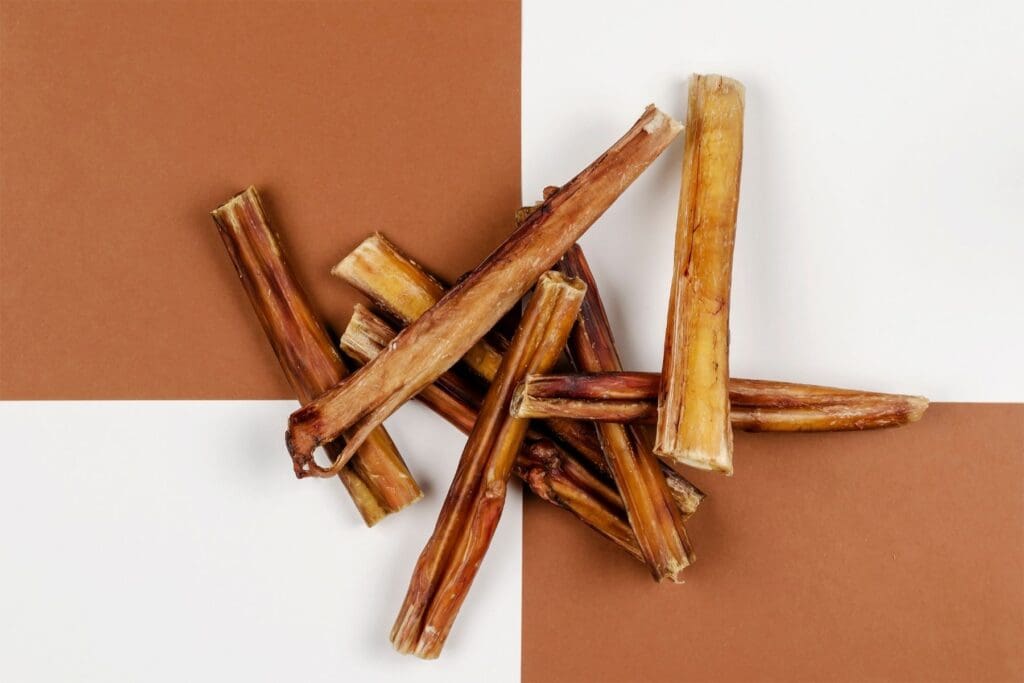

Bully sticks are good for all chewers, and you can get them in different sizes and thicknesses depending on the size of your dog, the condition of their teeth, and how aggressively they chew. A few things to watch out for with bully sticks:
- Avoid bully sticks with more than one ingredient (and that one ingredient should be beef pizzle), and find a company that does not treat their bully sticks with chemicals.
- Bully sticks, particularly the ends once your dog has mostly consumed it, can pose a choking risk. Monitor your pet while chewing, and you can even buy toys that hold the ends and help prevent choking.
- Bully sticks are 100% dead animal. This means they can smell funky, harbor bacteria, or strain fabrics. Make sure you give your dog a clean, safe space to enjoy that won’t contaminate areas frequented by humans.
We love buying bully sticks in bulk from Lonestar Dog Treats, and have also enjoyed bully sticks from Sancho and Lola’s Closet (also available on Amazon).
Raw edible bones
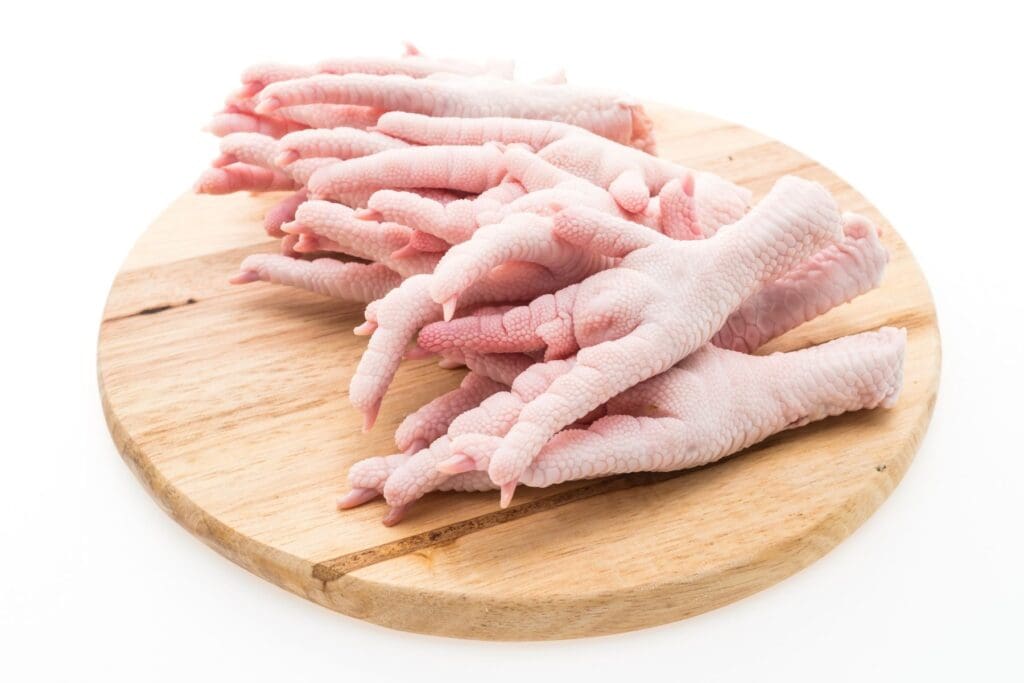

Edible bones are smaller, softer bones that, unlike marrow bones, are fully consumable. Because they are consumable and significantly softer than marrow bones, edible bones work for gentle and aggressive chewers alike. Examples of these bones include raw chicken feet, turkey necks, chicken backs, cow tails, etc. We especially love chicken feet for the glucosamine (great for joint health).
It is crucial to choose the right size of raw edible bone for your dog. For example, turkey necks are quite large and would not be appropriate for a small dog, while something like a chicken wing might pose a choking risk for a large dog. A few risks associated with raw edible bones include contamination, potential choking hazard, and pancreatitis. Try sourcing from a local farm or quality butcher, if possible, to reduce the risk of pathogens and bacteria, and keep frozen until it’s time to serve.
Another option could be a freeze dried or dehydrated edible bone (like those from Lonestar Dog Treats). These bones, gently cooked at very low temperatures, dramatically reduce the risk of contamination. However, any time you cook bones, especially chicken bones, you do run the risk of splintering which can be extremely dangerous!
Rolled Hides


Not to be confused with commercial rawhides, rolled hides (or hide strips) are processed without harmful chemicals or bleach. Usually they are hand-washed and gently dried at very low temperatures. Sourcing is crucial to quality, and again I choose Lonestar Dog Treats which sells cowhide rolls with and without hair from White Oaks Pastures, along with other animal hides like rabbit and alpaca. Choose the size that is right for your dog, and I recommend a hide strip for gentler chewers and a rolled hide for more aggressive chewers.
These rolled hides last forever, so I always collect them after about 10-15 minutes of chewing. I also store them in the freezer between chew sessions to prevent bacteria growth. These safe dog chews definitely stink (again, they are a dead animal), so I recommend feeding outside or creating a safe space for your dog to enjoy that you can easily disinfect after (ie NOT your bed).
Himalayan Yak Chews
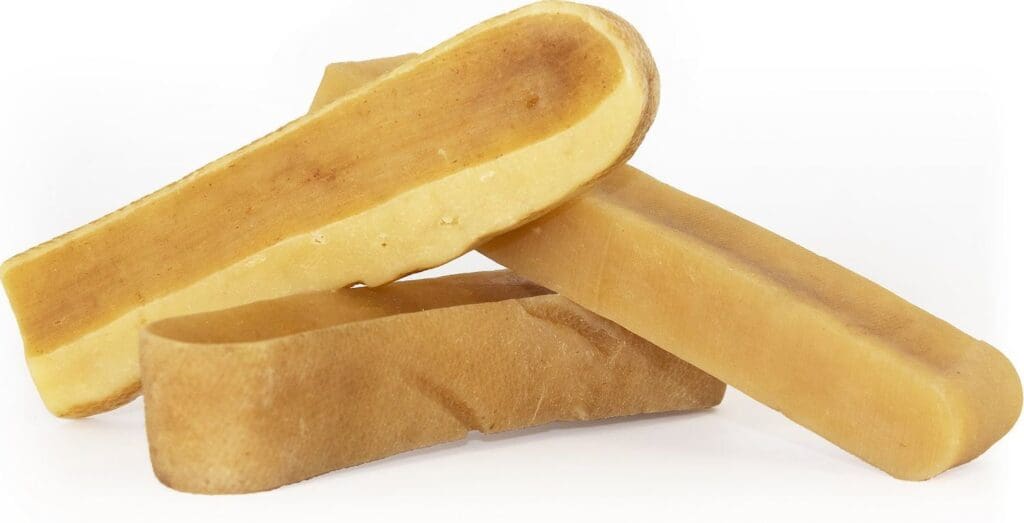

Himalayan Yak Chews are essentially a very hard cheese made from yak’s milk. These are good for soft to moderate chewers with healthy teeth. They are not suited for aggressive chewers with strong jaws, as I have seen some dogs (like June) break them into small pieces which could become a choking hazard.
That said, I like Himalayan chews because they are allergy friendly, limited ingredient, and fully digestible. Quality is important, and I really like this brand. As always, monitor your dog while chewing, and remove the chew after 10-15 minutes OR once the chew gets to a small enough size for your dog to swallow. You can take these nubs and microwave them to puff them into a crunchy snack! Just follow the instructions on the back of the bag. The girls absolutely LOVE these puffed bites.
Raw marrow bone
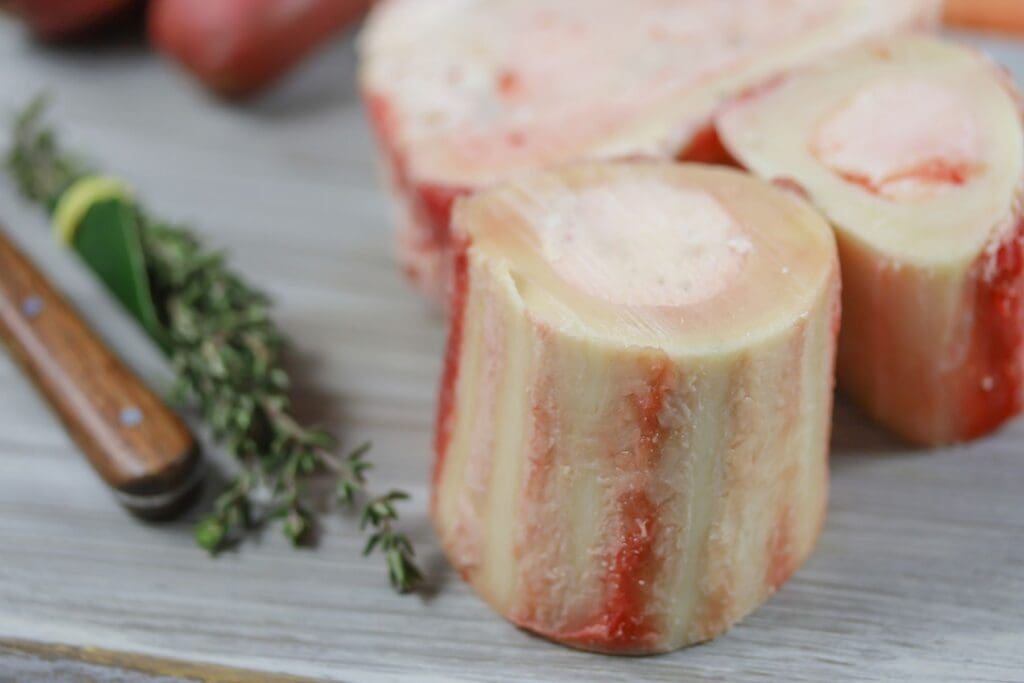

Raw marrow bones are usually large bones, like a femur, cut down into pieces 3-4 inches long to expose the marrow within. Humans use these bones for soups, but they can also make a good chew for your dog– IF they aren’t a hard chewer! Marrow bones are large and very hard, and they can easily chip a dog’s tooth.
This type of chew is best suited for moderate chewers or dogs who enjoy gnawing on the stringy bits stuck to the bone surface. These are tendons, and chewing on these bits of flesh are great for “flossing” between teeth and scraping away tarter.
I like to buy marrow bones from a local farm or butcher, and I keep them frozen until it’s time to serve. Like with most chews, monitor your dog closely to make sure they aren’t chewing too hard, and remove the treat after 10-15 minutes OR once the bone is scraped clean. Keep in mind this is a RAW BONE, which does present a contamination risk to both your pet and yourself.
Antlers


Antlers can be an excellent, long lasting chew that doesn’t smell or strain. However, these chews are quite hard and can easily chip a dog’s tooth. As such, I recommend antlers as a safe dog chew for gentle to moderate chewers with healthy teeth. I also consider antlers to be more appropriate for medium to large dogs than small dogs.
I like antlers for my dogs because they last like a Nylabone or Benebone, but they are 100% natural and chemical free. You can purchase antlers in varying sizes, so be sure to select the size that is appropriate for your dog. Antlers should never be swallowed, and I definitely recommend removing them after your dog has been chewing for 10-15 minutes since they are a harder chew.
Meet Your Dog’s Needs with Safe Dog Chews
When carefully selected to meet the needs of your specific dog, all of the above chews can provide a safe outlet for the very natural behavior of chewing. That said, all chews can pose a health risk. This can be anything from a chipped tooth to an intestinal blockage or even pancreatitis.
Luckily, there are lots of ways to meet your dog’s needs besides just chewing. Check out this post for a whole list of our favorite enrichment toys and activities.
How do you like to provide your dog healthy outlets for natural behaviors like chewing?




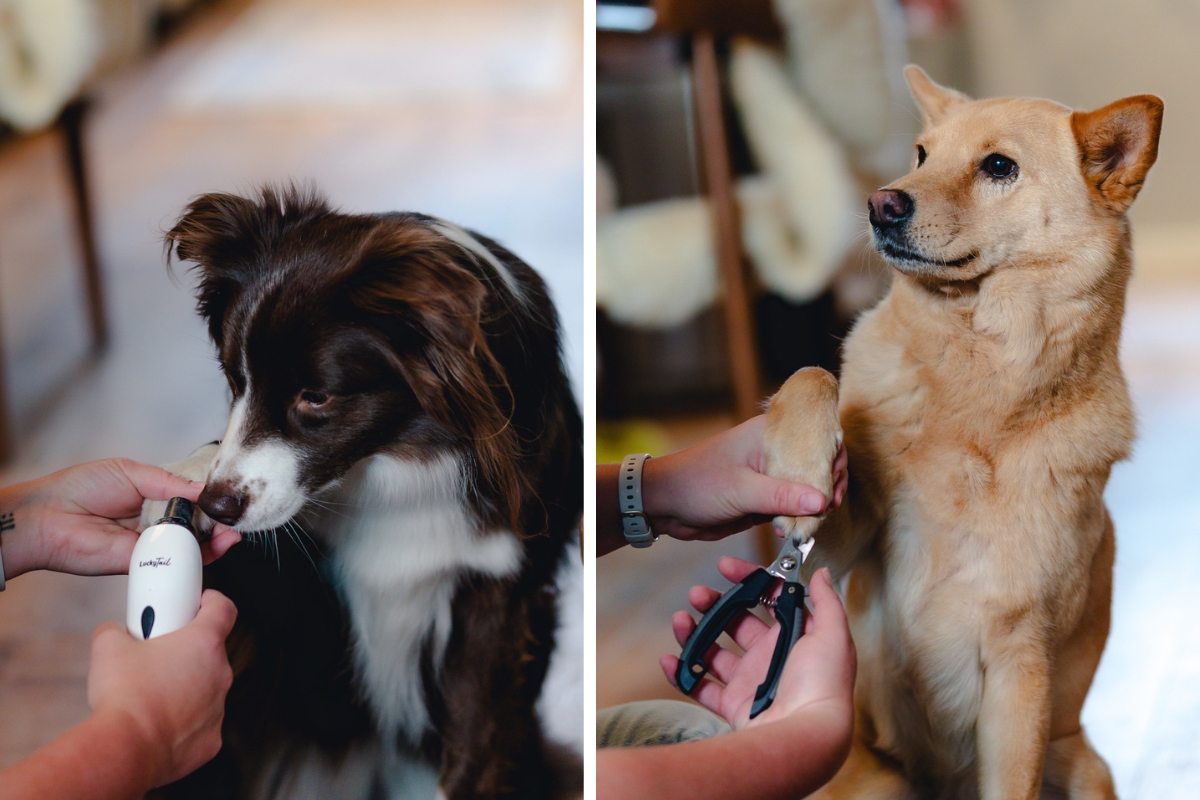

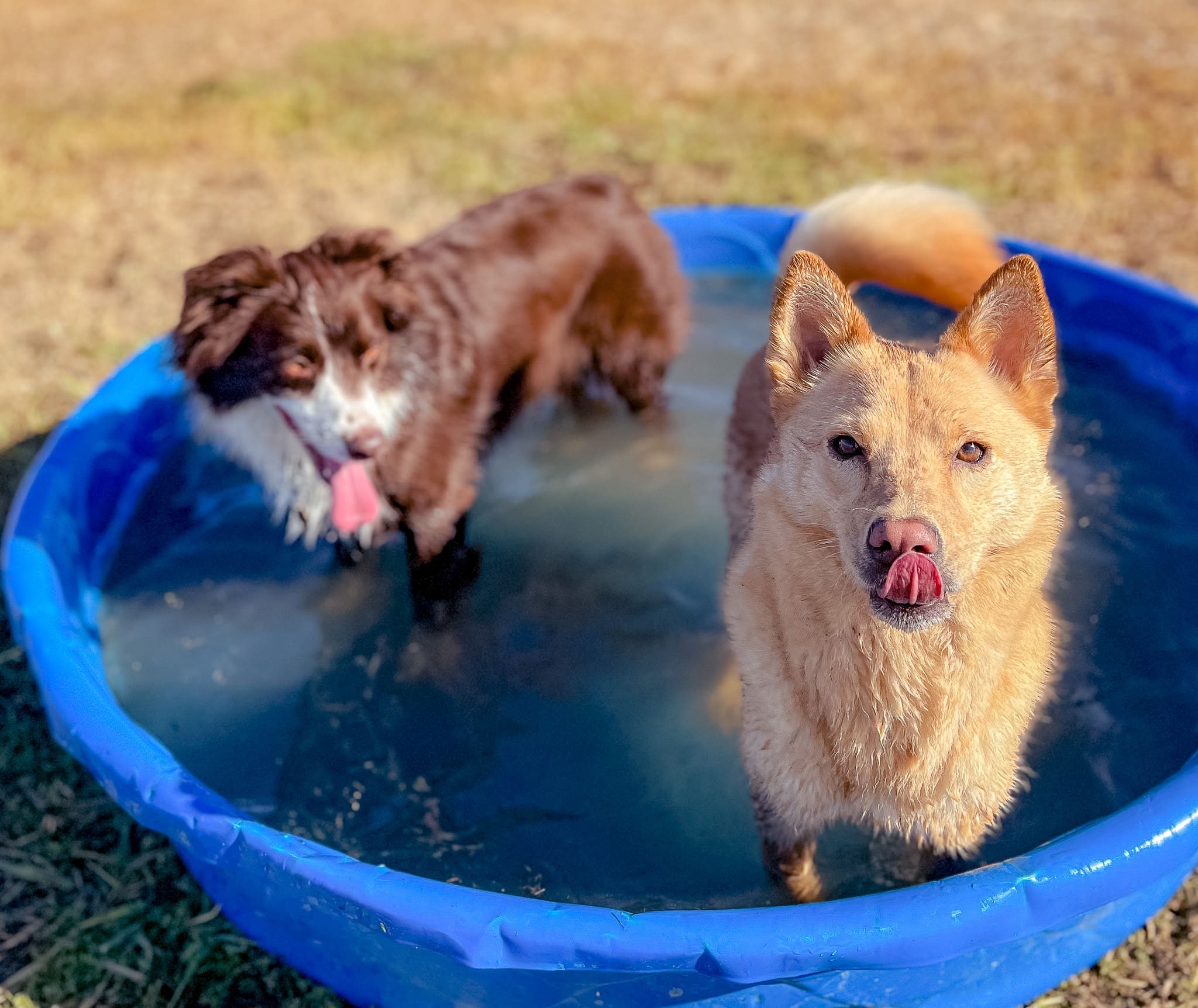

One Response